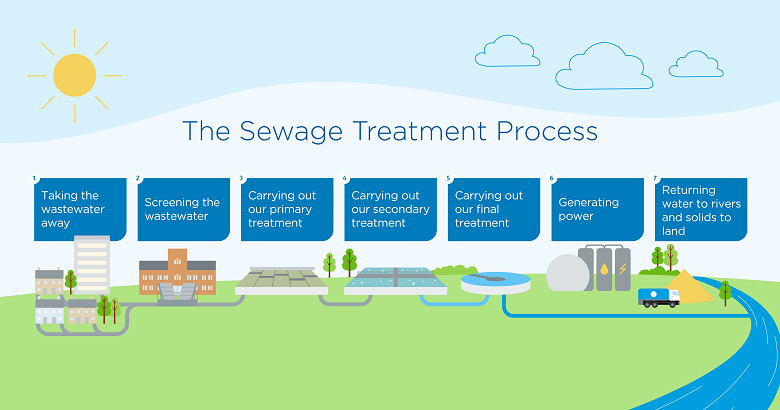Strategic Approaches to Enhance Drainage Treatment Efficiency and Minimize Ecological Influence
In the realm of waste water therapy, the quest for improved performance and reduced environmental impact is a continuous difficulty that demands critical services. The integration of sophisticated therapy innovations, energy-efficient processes, source healing techniques, improved nutrient removal techniques, and clever monitoring and control systems represents a complex framework for attending to these pressing worries.
Advanced Therapy Technologies
Innovative membrane layer filtering systems have transformed innovative wastewater treatment procedures, significantly boosting the elimination of contaminants. This innovation has verified to be extremely efficient in getting rid of a broad array of impurities, including drugs, heavy metals, and organic compounds, which are usually testing to remove with standard treatment techniques.
Moreover, membrane filtering systems supply countless benefits over conventional treatment techniques. Additionally, these systems are extremely functional and can be quickly incorporated into existing treatment plants or made use of as standalone systems for decentralized applications.
Energy-Efficient Processes
The integration of energy-efficient procedures in wastewater therapy systems is important for enhancing source utilization and decreasing operational prices. One essential method to enhancing power performance in wastewater therapy is the usage of sophisticated aeration systems, such as great bubble diffusers or surface aerators, which can enhance oxygen transfer efficiency and lower energy usage.
Furthermore, enhancing process control and automation with the use of sophisticated sensing units and monitoring systems can boost total power effectiveness by adjusting procedures in real-time based on real demand and problems. Implementing power audits and regularly keeping an eye on energy performance indications are essential methods to identify locations for enhancement and track energy-saving initiatives efficiently. In general, the adoption of energy-efficient procedures in wastewater treatment not only profits the setting however likewise adds to long-term price savings and functional sustainability.
Resource Recovery Techniques
With a concentrate on optimizing resource utilization and sustainability in wastewater treatment systems, the implementation of resource recuperation strategies becomes an essential facet in boosting functional performance. Source recovery techniques in wastewater therapy include the identification and removal of useful resources from the waste stream, consequently turning what was as soon as considered waste right into a useful asset. By applying resource recuperation strategies such as nutrient elimination and healing, power generation from raw material, and the manufacturing of recyclable water, wastewater treatment plants can decrease environmental impact while optimizing performance.

Boosted Nutrient Elimination Techniques
Implementing sophisticated nutrient removal strategies is vital for maximizing the performance of wastewater therapy systems. Enhanced nutrient elimination plays a vital function in lessening the environmental influence of treated effluent released into water bodies. One of the key methods made use of for enhanced nutrient removal is the process of organic nutrient elimination (BNR), which entails the elimination of nitrogen and phosphorus through organic processes. This can be accomplished through making use of specialized microorganisms that can convert nitrogen compounds right into inert nitrogen gas with denitrification, and build up phosphorus within their cells via a procedure called enhanced biological phosphorus removal (EBPR)

In addition to BNR, advanced treatment methods such as membrane bioreactors (MBRs) and built marshes can also be utilized to improve nutrient elimination performance. MBRs utilize membrane layers to attain top quality effluent criteria by properly eliminating nutrients and suspended solids. Built marshes mimic natural wetland procedures to eliminate nutrients via plant uptake, microbial activity, and sedimentation. By integrating these advanced nutrient elimination techniques right into wastewater therapy systems, communities and sectors can properly reduce nutrient contamination and secure the atmosphere.
Smart Tracking and Control Systems
Making use of sophisticated technology, the integration of clever tracking and control systems transforms the operational performance of wastewater treatment centers. These systems integrate sophisticated sensors and information analytics to constantly keep track of essential parameters such my explanation as pH degrees, turbidity, liquified oxygen, and flow rates in real-time. By accumulating and assessing this information, drivers can acquire valuable understandings right into the efficiency of the treatment procedures, enabling proactive modifications to enhance therapy effectiveness.
Smart surveillance and control systems additionally sustain remote tracking capabilities, allowing operators to accessibility real-time information and control features from off-site places. This remote ease of access enhances operational adaptability and responsiveness, allowing quick treatments in instance of system malfunctions or changes in influent high quality. The anticipating upkeep capabilities of these systems help stop tools failings and minimize downtime, eventually enhancing the total integrity of wastewater treatment operations.
Conclusion
In final thought, critical approaches such as sophisticated therapy innovations, energy-efficient procedures, resource healing approaches, boosted nutrient removal techniques, and clever tracking and control systems play a vital role in improving wastewater therapy effectiveness and minimizing environmental influence. By carrying out these methods, wastewater treatment plants can boost their general efficiency, decrease power usage, recover important resources, and make certain compliance with ecological policies. These strategies are vital for effective and sustainable wastewater monitoring techniques.

In verdict, calculated approaches such as sophisticated treatment technologies, energy-efficient processes, source recovery methods, boosted nutrient removal strategies, and wise monitoring and control systems play a crucial function in boosting wastewater treatment effectiveness and decreasing environmental effect.